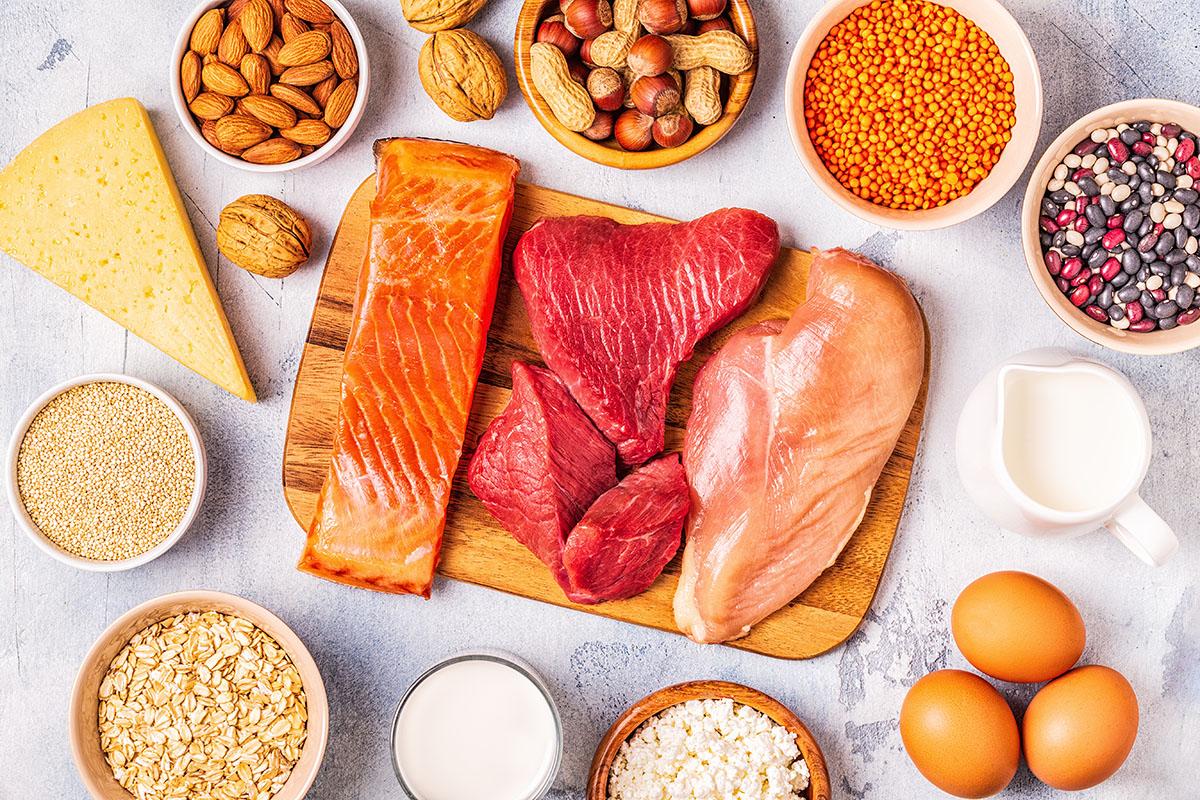Blog & Resources
Protein is an essential part of a balanced diet. Protein foods are great for satisfying hunger, boosting muscle formation, and helping you feel full. However, with so many options available in the protein food group it can be difficult to make wise choices. To help you out we’ve compiled some general tips to help guide your decision-making when it comes to picking protein foods.
Choose lean protein sources
When selecting protein foods, it’s important to choose leaner options most of the time. Lean protein sources are lower in saturated fat and calories, and they can help you maintain a healthy weight. Good lean protein choices include:
Poultry: chicken, turkey
- Buy skinless chicken parts, or take off the skin before cooking. Boneless skinless chicken breasts and turkey cutlets are the leanest poultry choices.
- Choose lean turkey, roast beef, ham, or low-fat luncheon meats for sandwiches instead of luncheon/deli meats with more fat, such as regular bologna or salami.
Fish: fresh or frozen, canned tuna or salmon, shrimp, pollock, catfish
Both tuna and salmon are good lean protein choices because they are low in saturated fat and calories. They are also a great source of omega-3 fatty acids, which are important for maintaining heart health.
Choose fish that are lower in mercury. These include shrimp, canned light tuna, salmon, pollock, and catfish. Albacore (white) tuna has more mercury than canned light tuna. So limit albacore tuna to 6 ounces (170 grams) a week.
Beef: round, sirloin, tenderloin
The leanest beef cuts include round steaks and roasts (eye of round, top round, bottom round, round tip), top loin, top sirloin, and chuck shoulder and arm roasts.
When it comes to ground beef, to be considered ‘lean,’ the product has to be at least 92% lean/8% fat.
Pork: pork loin, tenderloin
Pork chops and pork loin are the leanest pork cuts. Ham is also a good choice, but it can be high in sodium.
Lamb: loin chops and roasts
Lamb is a great source of lean protein, and when choosing lamb chops or roasts, it’s important to go for the leanest cuts.
Veal: loin chops and roast
Veal is a good protein choice because it is a low-fat, low-calorie source of protein. It also has a high concentration of nutrients, including zinc, thiamin, niacin, vitamin B6, and vitamin B12.
Watch out for added fat and salt
When you’re shopping for protein foods, be aware of added fats and salts. Some processed meats, such as hot dogs, sausages, and deli meats, are high in both fat and salt. Try to avoid these unhealthy choices whenever possible.
Other protein sources
In addition to meat, poultry, seafood, and beans, there are other foods that contain smaller amounts of protein that can be part of a healthy diet. These include:
Nuts and seeds: almond butter, peanut butter, pistachios, cashews, sunflower seeds
Dairy: Plain yogurt (regular, Greek), Skim or 1% milk, reduced-fat cheese, egg-white (buy them pre-packaged or separate the egg white from the yolk yourself)
Plant-based: There are also many plant-based foods that are high in protein, such as quinoa, legumes (beans, lentils, and peas), and tofu.
Include a variety of protein foods in your diet
It’s also important to include a variety of protein foods in your diet. This will ensure that when it comes to protein, variety is the key to a healthy diet. Incorporate a variety of protein foods into your meals and snacks, including both animal- and plant-based sources. This will help you get the nutrients you need for good health, and it will also help keep your meals interesting.
Choose seafood at least twice a week as the main protein food.
Look for seafood rich in omega-3 fatty acids, such as salmon, trout, and herring. Some ideas are:
- Salmon steak or filet
- Salmon loaf
- Grilled or baked trout
Choose beans, peas, or soy products as a main dish or part of a meal often. Some choices are:
- Chili with kidney or pinto beans
- Stir-fried tofu
- Split pea, lentil, minestrone, or white bean soups
- Baked beans
- Black bean enchiladas
- Garbanzo or kidney beans on a chef’s salad
- Rice and beans
- Veggie burgers
- Hummus (chickpeas spread) on pita bread
Choose unsalted nuts as a snack, on salads, or in main dishes. Use nuts to replace meat or poultry, not in addition to these items:
- Use pine nuts in pesto sauce for pasta.
- Add slivered almonds to steamed vegetables.
- Add toasted peanuts or cashews to a vegetable stir fry instead of meat.
- Sprinkle a few nuts on top of low-fat ice cream or frozen yogurt.
- Add walnuts or pecans to a green salad instead of cheese or meat.
What to look for on the food label
Check the NutritionFacts Label for the saturated fat, trans fat, cholesterol, and sodium content of packaged foods.
Processed meats such as hams, sausages, frankfurters, and luncheon or deli meats have added sodium. Check the ingredient and Nutrition Facts label to help limit sodium intake.
Fresh chicken, turkey, and pork that have been enhanced with a salt-containing solution also have added sodium. Check the product label for statements such as “self-basting” or “contains up to __% of __.”
Lower fat versions of many processed meats are available. Look on the Nutrition Facts label to choose products with less fat and saturated fat.
The good news
When it comes to getting enough protein in your diet, there is no need to go out of your way to consume large amounts of meat, poultry, or seafood. There are many other healthy protein sources available, including plant-based foods. So mix it up and include a variety of protein foods in your diet to make sure you’re getting all the nutrients you need.
